|
|
|
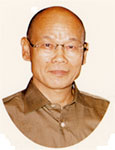 |
Dear Big fans of Japanese "Nishikigoi" On October 23rd, 2004, big earthquakes struck the home of Nishikigoi in Niigata Prefecture and killed 48 people (as of July 1st, 2005). Some 84,000 people, including all Nishikigoi breeders, are in shelters. As one of Japanese Nishikigoi dealers that have lived with the breeders and their Nishikigoi for over 40 years, I want to ask for your support to help them. Please read my report as well as the other pages of this site that show you what really happened in the home of Nishikigoi. Please help us protect Japan's very important heritage. Please support the Nishikigoi breeders who have been protecting and growing Japanese Nishikigoi for over 200 years. Yours sincerely, Mamoru Kodama Chair of Nishikigoi Protection Network |
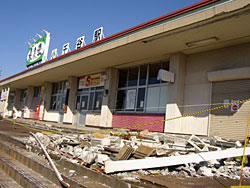 |
 |
| (photo #1) Ojiya City Station damaged. | (photo #2) Sufferers obliged to live in a local gym. |
At 17:56 pm on October 23rd, 2004, a 6.8-magnitude quake centered only 80 meters (262 feet) below ground of Yamakoshi Village, Koshi-County, Niigata Prefecture, Japan, rocked the area, ripping through roadways and rattling buildings. About 84,000 people who lived within 30 km (18.7 miles) from Yamakoshi Village and Ojiya City are still living in temporary shelters: in gyms at public schools (photo #2) or in their automobiles. They are frightened by hundreds of aftershocks that continued even after two weeks of the giant earthquake.
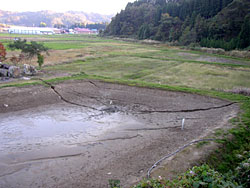 |
| (photo #3) Koi Pond cracked. |
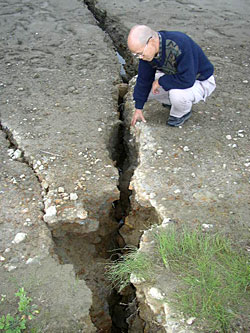 |
| (photo #4) The cracks swallowed millions of Nishikigoi "Tosai" |
If you are visiting this website, you probably are somebody who raises Nishikigoi.
There is more than a 95 percent probability that your Nishikigoi were born in the Yamakoshi or Ojiya area in Niigata. In other words, the skillful breeders who grew your Nishikigoi are suffering from one of the worst earthquakes ever.
I have worked with the breeders in Ojiya City as well as Yamakoshi Village over the past 40 years as a Nishikigoi dealer. On October 23rd, I was in Yamakoshi Village on business, but I fortunately had left at the time of the earthquake: an earthquake that measured 7 on the Japanese earthquake scale. When I went back to the area, I was dismayed at the heavy damages the earthquake caused. Everything was razed to the ground.
My second hometown, Yamakoshi, was completely isolated from the surrounding areas after its only road was torn away by a landslide that destroyed homes and Koi ponds. Most of the ponds in which the beautiful Nishikigoi were grown had disappeared. News about this earthquake was reported internationally, so I am quite sure you heard about it where you live. But please donft take it as something that happened somewhere far in the distance. It happened in your precious Nishikigoifs hometown.
About 650 Nishikigoi breeders lived in the mountain village. They were completely isolated because the roads were ripped in half and overpasses crashed right after the first big earthquake struck at 17:56pm on the 23rd. Unfortunately, it killed about 30 people in the area. On the 24th, all of the residents were rescued by helicopters dispatched by the Japanese Self-Defense Forces.
Your Koi's family members in Japan, parent Koi and sibling Koi, were swayed by and the landslide that upended Koi Ponds (photo #3 and #4). Yamakoshi Village and Ojiya City, birthplaces and proud producers of world-class Nishikigoi, lost almost all of their beautiful Nishikigoi in the earthquake. Nobody could find ways to fight against the disaster which changed their daily lives in a split moment.
 |
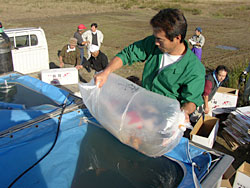 |
| (photo #5) Helicopter chartered to save the parent Nishikigoi |
(photo #6) Rescued the parent of Showa and Shiro-Utsuri |
However, after a week later, I saw that some of the breeders had gone back to their village by foot. They were working at the destroyed Koi ponds that they had abandoned for a week with the risk of losing their lives under critical condition. The area was still isolated, and nobody could predict when large aftershocks could occur, but it was their mission to pass on the tradition of Nishikigoi to the future. As the Japanese Self-Defense Forces did for the residents, they hired helicopters to save the Koi as well. In comparison to the original number of Nishikigoi, the number of those saved was small, but the disaster did not annihilate the best quality Nishikigoi.
I would like to send this message to all Nishikigoi fans. The birthplace of Nishikigoi, Ojiya City and Yamakoshi Village managed to survive. And as long as the courageous breeders continue to work for Nishikigoi, the area will be reconstructed and will once again enjoy the large natural fortune, Nishikigoi.
I would greatly appreciate your warm understanding of the critical situation and kind support for Nishikigoi in Niigata for prompt recovery. Your kind encouragement most certainly will give much energy to the people who have been struggling to overcome their despondency.
Let's save them. Let's support the recovery of Niigata, the birthplace of our beloved Nishikigoi.
With the strong belief in the recovery of Niigataand hope that we can be of help, I decided to organize this "Nishikigoi Protection Network" by starting a drive to raise funds. I hope that you will join us and give your support to the breeders of our beautiful Nishikigoi.
Mamoru Kodama, on November 8th 2004, on behalf of all Nishikigoi breeders in Niigata.